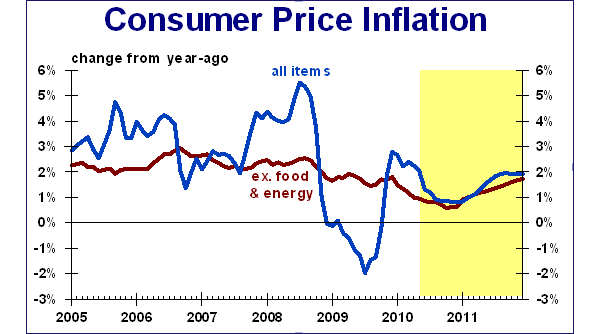Deflation? We Could Take a Sip
CPI drops have some alarmed. But falling prices are like booze: Fine in moderation, just not to be overdone.

With consumer prices falling for the second consecutive month in May, the prospect of deflation is provoking some angst. Thanks to recent weakness in food and energy prices, overall inflation for the most recent 12-month period has been a modest 2% -- slightly lower than the 2.5% pace averaged over the past decade.
Before inflation firms up next year, consumers are likely to enjoy further declines. More important, core inflation -- the rate of price increases for the 78% of products and services in the index that aren’t either energy or food -- is likely to continue to wane. That’s critical because food and energy prices can be notoriously misleading indicators when it comes to discerning inflation trends. During the commodity price boom of 2007-08, for example, inflation was a steep 5%, even though stripping out food and energy components yielded a “core” rate just half that level. Conversely, the commodity price collapse of 2008-09 resulted in prices falling 2% -- deflation -- while the core price measure still posted a modest 1.5% gain.
For the past 12 months, core inflation climbed a mere 0.9%, the lowest increase since 1966, and it’s headed still lower. One reason: Housing, which accounts for 31% of the Consumer Price Index. Even though house prices have stabilized over the past year, the glut of unoccupied homes and apartments is driving down rents, and that’s the way the government measures housing prices. It focuses on “rental equivalents,” or what properties would lease for on the open market. And because rents are renewed when leases expire, they tend to lag behind house prices by up to a year.

Sign up for Kiplinger’s Free E-Newsletters
Profit and prosper with the best of expert advice on investing, taxes, retirement, personal finance and more - straight to your e-mail.
Profit and prosper with the best of expert advice - straight to your e-mail.
As inflation drifts lower, the greater deflation fears will become. Policymakers, especially those at the Federal Reserve, worry about it because when falling prices persist, they are typically accompanied by falling wages, making debt burdens -- already onerous -- more difficult to carry. After all, debt levels don’t automatically adjust downward, and interest rates are about as low as we can realistically expect. So the burden of servicing existing debts eats up a larger and larger portion of diminishing real incomes. That was the story here in the 1930s and in Japan during the 1990s.
But flirting with deflation, and maybe even experiencing it briefly, isn’t necessarily bad. One reason is that wages tend to be “sticky” -- they adjust only gradually to changing circumstances. So when prices dip briefly but wages do not, the effect is to increase the purchasing power of people’s incomes. During the commodity price bust of 2008-09, for example, hourly wages were advancing at a modest 3.3% pace. But because prices fell 2%, that translated into an effective, or “real,” wage gain of 5.3%. Consumers benefited from falling prices, and spending didn’t shrink as much as it might have if real incomes were lower.
Another benefit of short-term deflation would come through its impact on interest rates. As a rule, part of the compensation that investors in fixed income securities require accounts for the risk of future inflation. But when deflation looms and the risk of inflation is seen as low, the risk premium declines and interest rates fall. That, of course, would buoy spending on big-ticket items, such as business equipment, houses and cars.
The bottom line is that persistent deflation poses some serious risks and it’s important not to be complacent about it. But as long as deflation isn’t overdone, we won’t end up with a hangover.

Get Kiplinger Today newsletter — free
Profit and prosper with the best of Kiplinger's advice on investing, taxes, retirement, personal finance and much more. Delivered daily. Enter your email in the box and click Sign Me Up.

-
 Stock Market Today: Stocks Soar on China Trade Talk Hopes
Stock Market Today: Stocks Soar on China Trade Talk HopesTreasury Secretary Bessent said current U.S.-China trade relations are unsustainable and signaled hopes for negotiations.
By Karee Venema
-
 2026 Disney Dining Plan Returns: Free Dining for Kids & Resort Benefits
2026 Disney Dining Plan Returns: Free Dining for Kids & Resort BenefitsPlan your 2026 Walt Disney World vacation now. Learn about the returning Disney Dining Plan, how kids aged three to nine eat free, and the exclusive benefits of staying at a Disney Resort hotel.
By Carla Ayers
-
 The Economic Impact of the US-China Trade War
The Economic Impact of the US-China Trade WarThe Letter The US-China trade war will impact US consumers and business. The decoupling process could be messy.
By David Payne
-
 AI Heads to Washington
AI Heads to WashingtonThe Kiplinger Letter There’s big opportunity for AI tools that analyze MRIs and other medical images. But also big challenges that clinicians and companies will have to overcome.
By John Miley
-
 The AI Doctor Coming to Read Your Test Results
The AI Doctor Coming to Read Your Test ResultsThe Kiplinger Letter There’s big opportunity for AI tools that analyze CAT scans, MRIs and other medical images. But there are also big challenges that human clinicians and tech companies will have to overcome.
By John Miley
-
 The New Space Age Takes Off
The New Space Age Takes OffThe Kiplinger Letter From fast broadband to SOS texting, space has never been more embedded in peoples’ lives. The future is even more exciting for rockets, satellites and emerging space tech.
By John Miley
-
 Rising AI Demand Stokes Undersea Investments
Rising AI Demand Stokes Undersea InvestmentsThe Kiplinger Letter As demand soars for AI, there’s a need to transport huge amounts of data across oceans. Tech giants have big plans for new submarine cables, including the longest ever.
By John Miley
-
 What DOGE is Doing Now
What DOGE is Doing NowThe Kiplinger Letter As Musk's DOGE pursues its ambitious agenda, uncertainty and legal challenges are mounting — causing frustration for Trump.
By Matthew Housiaux
-
 A Move Away From Free Trade
A Move Away From Free TradeThe Letter President Trump says long-term gain will be worth short-term pain, but the pain could be significant this year.
By David Payne
-
 Trump’s Whirlwind Month of Crypto Moves
Trump’s Whirlwind Month of Crypto MovesThe Kiplinger Letter The Trump administration wants to strengthen U.S. leadership in the cryptocurrency industry by providing regulatory clarity.
By Rodrigo Sermeño